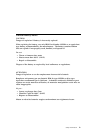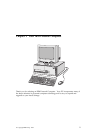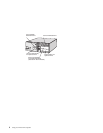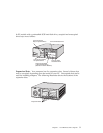High-Capacity Hard Disk Drives
Some PC models have a hard disk drive with an EIDE (enhanced integrated drive
electronics) bus master interface to transmit data to and from the hard disk drive.
The EIDE interface specification, which is an extension of the original IDE interface
specification, refers to a hard disk drive with the controller built into the drive (as
opposed to a hard disk drive with a separate controller). The single-unit drive and
controller plugs into one of two EIDE connectors located on the system board of
your computer. You can connect an additional hard disk drive to the ribbon cable
already attached to the system board. You can also purchase another cable and
connect two more hard disk drives or other IDE or EIDE devices to the second
connector on the system board. Your computer will accommodate up to four IDE
or EIDE devices. Both EIDE connectors are attached through a PCI-based controller.
Some PC models have a hard disk drive with a type of interface referred to as SCSI
(small computer system interface). These computers have a SCSI adapter installed
in one of the expansion slots. The SCSI adapter has one external 68-pin, 16-bit
connector; one internal 50-pin, 8-bit internal connector; and one internal 68-pin,
16-bit connector. With this adapter, you can connect up to 15 peripheral devices to
your PC. (However, the number of internal SCSI devices you can install is limited
by the number of available drive bays in your computer.)
SCSI can be faster than EIDE, particularly when used with a multitasking operating
system, such as OS/2 or Microsoft Windows NT. With SCSI, instructions can be
sent concurrently to every drive in the system, and the drives can then execute these
instructions simultaneously. This is not possible with EIDE. Also, with SCSI, it is
possible to add more peripheral devices to your PC than with EIDE. SCSI is well
suited for high-performance computers, or for computers in which expandability is
important. However, EIDE is desirable for many computer users because it is more
economical than SCSI, it has high-performance capabilities, and it is easier to
connect devices. Also, when used in a stand-alone computer with a single-tasking
operating system, such as DOS or Windows, EIDE can sometimes be faster than
SCSI.
CD-ROM Drive
A CD-ROM drive is installed in some PC models. CD-ROM (compact disc
read-only memory) technology offers quick access to enormous amounts of
information. A compact disc can store more than 650 MB of data, such as the large
files needed for audio, still and full-motion video, and still and animated graphics.
A CD-ROM drive can play back or read from a CD, but it cannot write information
on it.
Chapter 1. Your IBM Personal Computer 3


















